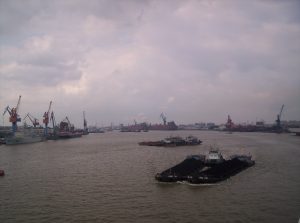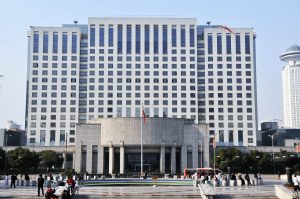Shanghai
25 Economy/Politics
Jorge I. Alcocer
Economy & Transportation
Shanghai has one of the largest seaports in the world and has a major industrial and economical importance for China: Shanghai contributed more than 3 trillion Renminbi (USD 448 billion) to China’s GDP in 2017. Shanghai was also of China’s first seaports to be open to western trade which enabled it to become the leading city in China’s commerce. Shanghai is also one of China’s leading manufacturing and industrial centers and the city’s machine industry has been key in China’s modernization plans.

For a long time now, Shanghai has been China’s leading city for industrial and manufacturing services due to several factors including: the availability of a workforce that was large in size, highly trained, skilled, and technologically innovated. Shanghai also has access to a scientific research center that supports industrial endeavors, a long standing tradition of receiving cooperation from producers, and an internal and external communications system that is well coordinated with supply facilities.
The iron and steel industries in Shanghai were one of the first to be established in China. In the 1950s, the introduction of blast furnaces caused Shanghai’s iron and steel industry to grow then later, in the 1970s, iron and steel companies started creating new facilities in the northern region of Shanghai one of which was the Shanghai Baosteel Group Corporation which has been one of the world’s largest enterprises in the 21st century. Shanghai also has two major banks: the China Construction Bank and the Bank of China, both of which serve as administrative branches to China’s Ministry of Finance. Meaning that they are responsible for management and disbursement of capital investment funds.

Shanghai is one of China’s largest centers for major transportation. The central city acts as both a seaport and a river port. Being located near the Huangpu River allows Shanghai to have a harbor that allows ocean transports to sail through the river and into the city. During the 1950s, many of the districts in Shanghai were used as different specialized sections such as some sections being used for storage and others being used as transportation maintenance and repair resources. Now there are at least 125 docks and 19 terminals throughout Shanghai and its districts. Shanghai’s railroad system began construction in the 1870s but was later reoriented in the 1940s in order to balance exports and domestic development necessities. Recently, in 2011, a high-speed rail line connected Shanghai and Beijing, greatly reducing the travel time between both cities.
Politics

In general, the Shanghai Municipality is overseen by the central government within Beijing. During the Cultural Revolution in the 1960s, China began to reorganize their governmental systems and levels of hierarchy and in 1967 the Shanghai Municipal Revolutionary Committee became the dominant governing system in Shanghai after much disarray between revolutionary parties attempting to seize control of the city.
Later, the Shanghai Municipal Revolutionary Committee was replaced by another municipal government body that was made up of several offices, commissions, and bureaus under the control of an elected body called Shanghai People’s Congress. This government body serves as a policy advisory and administrative function that also serves as a link between the national government located in Beijing as well as the local governments surrounding Shanghai’s municipality.
Works Cited
“Economy of Shanghai.” Encyclopædia Britannica, Encyclopædia Britannica, Inc., https://www.britannica.com/place/Shanghai/Economy .
“Administration and Society.” Encyclopædia Britannica, Encyclopædia Britannica, Inc., https://www.britannica.com/place/Shanghai/Administration-and-society.
Media Attributions
- 3092447994_0ece136d35_o

